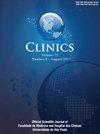Can elastography predict early allograft dysfunction or loss after liver transplantation? A prospective study of diagnostic accuracy
IF 2.4
4区 医学
Q2 MEDICINE, GENERAL & INTERNAL
引用次数: 0
Abstract
Introduction
The imbalance between the demand for liver transplants and the shortage of donors can be addressed by expanding the donor pool, including using extended criteria donors. This strategy may reduce waiting time and list mortality but can increase poor graft function rates, affecting short-term outcomes. Tools to predict and diagnose Early Allograft Dysfunction (EAD) are crucial. Elastography for Liver Stiffness Measurement (LSM) may predict EAD and graft loss early post-transplant.
Methods
In this prospective observational study, the authors assessed the diagnostic accuracy of elastography for predicting EAD or loss in liver transplant recipients admitted to the ICU of Hospital das Clínicas, Universidade de São Paulo, from 2016 to 2018. Patients underwent daily LSM from ICU admission to day 7 post-transplant. EAD was defined by Olthoff et al.'s criteria, and allograft loss was defined by the need for retransplantation or death within 180 days.
Results
EAD developed in 27 patients (44.3 %). The median LSM was 2.12 m/s (IQR 1.87–2.67 m/s) for the EAD group and 1.70 m/s (IQR 1.55–1.90 m/s) for the non-EAD group. For predicting EAD, elastography on day 1 had a c-statistic of 0.83, sensitivity 41 %, specificity 97 %, and accuracy 83 % at a cutoff of 2.39 m/s. For predicting early allograft loss, the c-statistic was 0.93, with a sensitivity 76 %, specificity 100 %, and accuracy 93 % at a cutoff of 2.25 m/s on day 1.
Conclusion
Elastography demonstrated robust performance in predicting EAD and early graft loss post-transplant, outperforming traditional prognostic scores. Further multicenter studies are needed to confirm these findings.
弹性图能预测肝移植后早期异体移植物功能障碍或丧失吗?诊断准确性的前瞻性研究
肝移植需求和供体短缺之间的不平衡可以通过扩大供体库来解决,包括使用扩展标准的供体。这种策略可以减少等待时间和名单死亡率,但可能增加移植物功能不良的发生率,影响短期预后。预测和诊断早期同种异体移植物功能障碍(EAD)的工具至关重要。肝刚度测量弹性图(LSM)可以预测移植后早期的EAD和移植物损失。方法在这项前瞻性观察性研究中,作者评估了2016年至2018年圣保罗大学das医院Clínicas ICU住院的肝移植受者的弹性成像预测EAD或损失的诊断准确性。患者从ICU入院到移植后第7天每天进行LSM。EAD的定义是Olthoff等人的标准,同种异体移植物损失的定义是在180天内需要再移植或死亡。结果27例(44.3%)患者发生ad。EAD组平均LSM为2.12 m/s (IQR为1.87 ~ 2.67 m/s),非EAD组平均LSM为1.70 m/s (IQR为1.55 ~ 1.90 m/s)。对于预测EAD,弹性成像在第1天的c统计量为0.83,灵敏度为41%,特异性为97%,准确度为83%,截止值为2.39 m/s。对于预测早期同种异体移植物损失,c统计量为0.93,敏感性为76%,特异性为100%,在第1天的截止值为2.25 m/s时,准确性为93%。结论弹性成像在预测EAD和移植后早期移植物损失方面表现良好,优于传统的预后评分。需要进一步的多中心研究来证实这些发现。
本文章由计算机程序翻译,如有差异,请以英文原文为准。
求助全文
约1分钟内获得全文
求助全文
来源期刊

Clinics
医学-医学:内科
CiteScore
4.10
自引率
3.70%
发文量
129
审稿时长
52 days
期刊介绍:
CLINICS is an electronic journal that publishes peer-reviewed articles in continuous flow, of interest to clinicians and researchers in the medical sciences. CLINICS complies with the policies of funding agencies which request or require deposition of the published articles that they fund into publicly available databases. CLINICS supports the position of the International Committee of Medical Journal Editors (ICMJE) on trial registration.
 求助内容:
求助内容: 应助结果提醒方式:
应助结果提醒方式:


